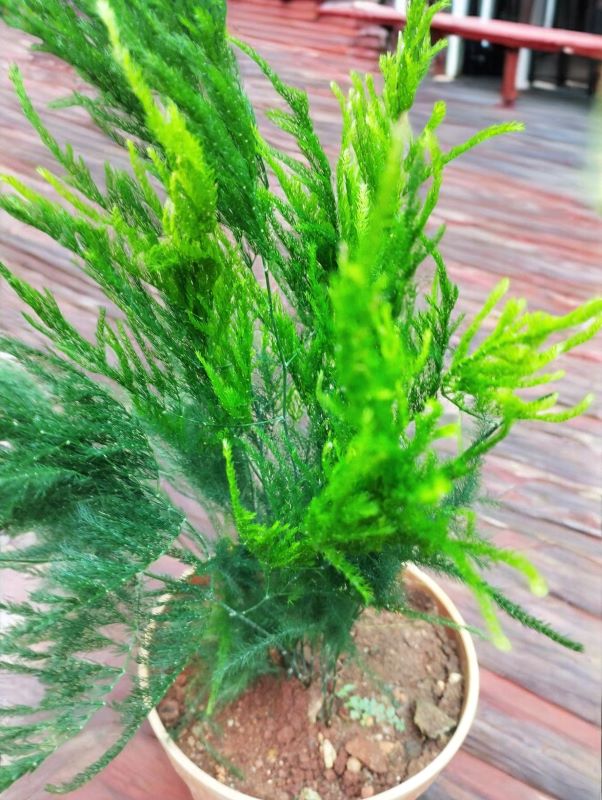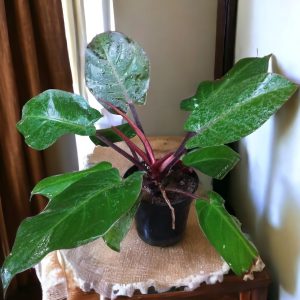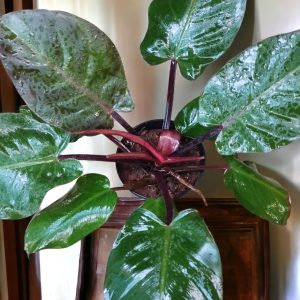Asparagus Setaceus Pyramidalis, Asparagus Fern or Lace Fern
This product is available for shipping only in Bangalore
Asparagus setaceus Pyramidalis is an decorative foliage plant, with a bushy, upright habit. It forms shoots of lacy, fern-like plumes, with a dense pyramid-like growth. Asparagus setaceus is native to tropical and subtropical parts of eastern and southern Africa, where it grows as an evergreen perennial scrub in rainforests and forest edges. Asparagus setaceus Pyramidalis makes for a great houseplant. It is commonly known as Pyramid fern; Feathery asparagus; Lace fern or Asparagus fern. Evanthia has seeds available of Asparagus setaceus Pyramidalis all year round.
Plant Height: approx 12 inches including the pot
Pot size : 5 inches nursery pot
- Estimated Delivery : Up to 3 business days
- Free Shipping & Returns : On all orders over ₹550 in Bangalore
Asparagus setaceus Pyramidalis, commonly known as the Asparagus Fern or Lace Fern, is a popular ornamental plant known for its delicate, feathery foliage that resembles fern fronds. Despite its common name, it is not a true fern but a member of the Asparagus family. The cultivar ‘Pyramidalis’ has a more upright, bushy growth habit, making it a perfect choice for creating a striking focal point in containers, hanging baskets, or garden beds. Here’s a comprehensive guide to caring for Asparagus setaceus Pyramidalis:
1. Light Requirements
- Bright, Indirect Light: Asparagus setaceus Pyramidalis thrives in bright, indirect light. It is well-suited for growing near a window with filtered sunlight. Too much direct sunlight can scorch its delicate fronds, while too little light may cause it to become leggy and lose its lush appearance.
- Partial Shade: It can tolerate partial shade, making it versatile for indoor or outdoor locations with dappled sunlight.
2. Watering
- Regular Watering: Keep the soil consistently moist but not soggy. Water the plant regularly, especially during the growing season (spring and summer), allowing the top inch of soil to dry out slightly between waterings.
- Reduce Watering in Winter: During the dormant period in winter, reduce the frequency of watering, allowing the soil to dry out more between waterings.
3. Soil
- Well-Draining Soil: Use a well-draining, loamy potting mix rich in organic matter. A mix of peat moss, garden soil, and perlite works well to ensure good drainage and aeration.
- Slightly Acidic to Neutral pH: A soil pH range of 6.0 to 7.0 is ideal for Asparagus setaceus Pyramidalis.
4. Temperature and Humidity
- Moderate Temperatures: This plant prefers temperatures between 60-75°F (15-24°C). It is not frost-tolerant and should be protected from temperatures below 50°F (10°C).
- High Humidity: Asparagus ferns thrive in high humidity environments. If grown indoors, maintain humidity by misting the plant regularly or using a humidity tray. Avoid placing it near heating vents or drafts that can dry out the air.
5. Fertilizing
- Regular Feeding: Fertilize every 4-6 weeks during the growing season with a balanced, water-soluble fertilizer (e.g., 10-10-10) to promote lush, green growth.
- Organic Alternatives: Use compost or liquid seaweed as an organic option to enrich the soil and provide nutrients.
6. Pruning and Maintenance
- Prune for Shape: Prune the plant regularly to maintain its shape and remove any yellow or dead fronds. Pruning encourages bushier growth and keeps the plant looking neat.
- Thinning: If the plant becomes too dense, thin out some of the older stems to improve air circulation and light penetration.
7. Propagation
- Division: Asparagus setaceus Pyramidalis can be propagated through division. Carefully divide the root ball during repotting, ensuring each division has a portion of the root system and healthy shoots. Plant the divisions in separate pots with fresh potting mix.
- Seeds: The plant can also be propagated from seeds, although this method is slower. Collect seeds from mature berries, clean them, and sow them in a seed-starting mix.
8. Pests and Diseases
- Common Pests: Look out for pests like spider mites, aphids, and mealybugs, which can infest the plant. Inspect regularly and treat infestations with insecticidal soap or neem oil.
- Fungal Issues: Ensure good air circulation around the plant and avoid overwatering to prevent fungal diseases such as root rot. Avoid overhead watering to keep the foliage dry.
9. Indoor vs. Outdoor Growing
- Indoor Growing: Asparagus setaceus Pyramidalis is popular as an indoor plant due to its decorative foliage and ability to adapt to various lighting conditions. Place it in a bright location with indirect light and maintain humidity levels to keep the plant healthy.
- Outdoor Growing: In suitable climates, it can be grown outdoors in shaded or partially shaded garden areas. Provide support if needed, as the plant may have a climbing habit.
10. Toxicity
- Mildly Toxic: The berries of Asparagus setaceus Pyramidalis are mildly toxic if ingested and can cause gastrointestinal discomfort. Keep the plant out of reach of pets and children.
11. Container Growing
- Pot Requirements: Choose a container with drainage holes to prevent waterlogging. Use a high-quality, well-draining potting mix and repot the plant every 1-2 years or when it becomes root-bound.
- Hanging Baskets: Its cascading foliage makes it an excellent choice for hanging baskets, where its fronds can drape elegantly over the sides.
12. Overwintering
- Indoor Protection: In colder regions, bring the plant indoors before the first frost. Place it in a bright location and reduce watering during the winter months.
By following these care tips, your Asparagus setaceus Pyramidalis will thrive, providing a lush, green display of delicate, fern-like foliage that adds elegance and charm to any indoor or outdoor space. Its versatility and ease of care make it a popular choice among plant enthusiasts and gardeners alike.
** Plants photos are for representation purpose only. We will make best efforts to send the plants as in photos itself, however it is not always guaranteed as plants might overgrow or shrink depending on the season, care or age. Trust us, we want to give you the best.















Reviews
There are no reviews yet.